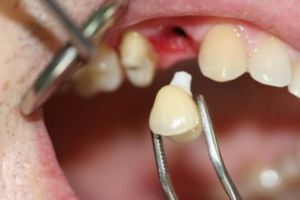 Often in the process of life, a person, with no matter whether an adult or a child, can receive various kinds of injuries. This situation can also affect the teeth during a dislocation, fracture, or when they are knocked out whole, including the root.
Often in the process of life, a person, with no matter whether an adult or a child, can receive various kinds of injuries. This situation can also affect the teeth during a dislocation, fracture, or when they are knocked out whole, including the root.
The exit in this case will be the carrying out of the replacement of the damaged tooth in the dental clinic, which must necessarily be done by qualified specialists.
Contents of
- What is it?
- Indications and contraindications for operation
- Varieties of intervention
- Preparatory stage
- Stages of
- Pros and cons
- Price of issue
What is it?
Replantation, as a rule, is the return of a lost tooth to its own well or otherwise its own alveolar bed. In this case, the tooth can continue to be in the hole, but it is not fixed in it.
In practice, the front group of teeth is more at risk, because they have only one root. Accordingly, it is easier for them to break away from their base without fractures.
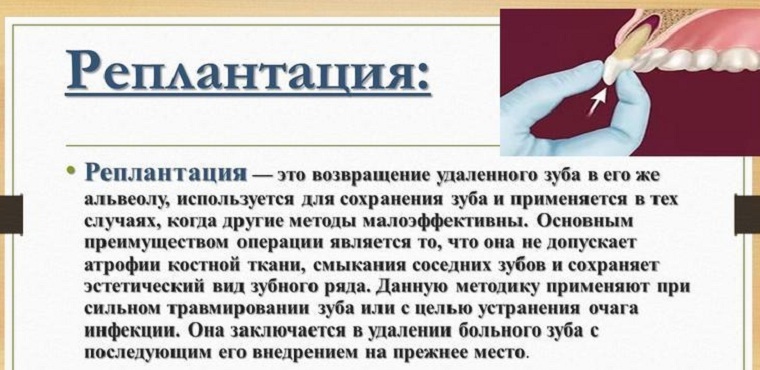
Indications and contraindications for operation
There are a number of indications for the re-implantation, which are contained in the following:
- the presence of of chronic periodontitis , which does not lend itself to traditional methods of treatment or when removal of the apex of the root is impossible;
- fixation of holes in the root of the tooth ;
- manifestation of acute purulent inflammation of the periosteum( odontogenic periostitis of the jaw );
- preservation of a dislocated tooth , provided that it is healthy.
Contraindication to tooth replacement may be the presence of:
- extensive carious lesion, since the probability of engraftment in this position is small;
- inflammatory process, then a delayed procedure will be required;
- significant cracks in the enamel;
- of curved roots;
- cardiovascular disease;
- of mental illness;
- of acute infectious diseases;
- malignant tumors;
- acute radiation sickness.
Without fail, taking into account all indications and contraindications, the doctor decides on a possible replantation.
Types of intervention
Tooth transplantation can be performed in two ways: 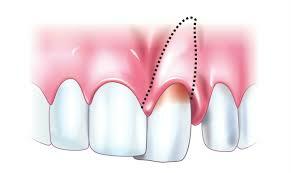
- Devital - consists in the initial removal of the nerve in the problem tooth, and there is no fundamental difference where it is located in the oral cavity. After that, the doctor proceeds to fill the root canals, and the hole is thoroughly cleaned from the tissues that were affected. The next action is expressed in the cutting of the tip, which can affect both one root and several, and then the tooth is set to its original position.
- Vital - is aimed at preserving the nerve of the tooth and refusing to seal the canals. This approach allows the functioning of the tooth for ten years, and sometimes more.
The experience of a specialist has a direct impact on the success of the entire operation as a whole, so it's worth to turn to professionals.
Preparatory phase of
Before proceeding directly to the operation, the dentist must carefully inspect the tooth and the well from which it was extracted.
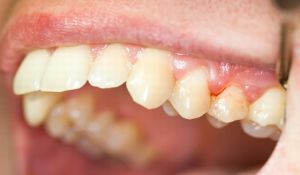 If necessary, the removal of plaque and calculus, treatment of caries. If the expert notes the presence of favorable conditions, the tooth is subjected to endodontic treatment. Such manipulations are carried out with the aim to get rid of the organic component in the root of the tooth and prevent the development of infection.
If necessary, the removal of plaque and calculus, treatment of caries. If the expert notes the presence of favorable conditions, the tooth is subjected to endodontic treatment. Such manipulations are carried out with the aim to get rid of the organic component in the root of the tooth and prevent the development of infection.
Due to injury, the neurovascular bundle tends to detach and become viable, so that it decomposes.
Accordingly, it is the source of infection, and therefore periodontitis occurs and the engraftment of the tooth is difficult. Endodontic treatment is produced only under x-ray control. Sometimes it is carried out a week or two after the re-implantation.
Stages of
In order to achieve a successful result from the operation of the replantation, it is necessary to observe the following stages of treatment:
- extraction from the socket of the tooth and placing it in a solution of sodium chloride with the addition of an antibacterial agent;

- carrying out revision of the hole, removal of chronic foci of inflammation, followed by washing the oral cavity with a special solution containing antibiotic;
- determination of the viability of the pulp at the site of the extracted tooth, in case of death it is necessary to completely remove it, and then proceed to the filling of the channels with a fast-hardening plastic or phosphate cement, and then proceed to remove the apex of the roots;
- accurate return of the tooth in the hole, while the task of the doctor is to give him a physiological position;
- fixation of the tooth with a tire or kappa for a period of one to one and a half months;
- is compulsory adherence to a special diet that involves the rejection of any solid food, and three or four sessions of ultra-high-frequency therapy( UHF therapy) may be prescribed.
During the whole period of tooth engraftment, the orthodontist observes the course of the process. With the correct implementation of all the above steps and with the observance of all subsequent recommendations, we can safely talk about the successful outcome of the operation.
Advantages and disadvantages of
The main advantages of replantation include the following:
- restoration and preservation of the tooth extracted for some reason;
- carrying out operational actions in one step;
- implantation of the tooth even if it was outside the oral cavity for more than a day due to the availability of modern equipment in some clinics;
- aesthetic and functional components of the replanted tooth can last up to twenty years.
In the category of disadvantages you can include:
- the probability of not engrafting the tooth is high;
- observance of a sparing diet in the postoperative period must be combined with taking analgesics and antibiotics;
- the presence of a number of the above-mentioned diseases is a limitation for the operation;
- because of the significant damage to the crown operation is often impossible.
The most important drawback is non-healing, as it is impossible to predict how the tooth will behave in the future, even if the patient follows all rules of the postoperative period.
Price issue
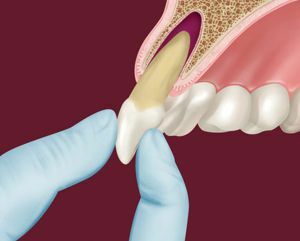 The price of replantation depends, first of all, on how many roots the tooth has. The average cost of the procedure with a multi-rooted tooth will be about eight hundred rubles, and the one-rooted will cost more - about one thousand three hundred rubles.
The price of replantation depends, first of all, on how many roots the tooth has. The average cost of the procedure with a multi-rooted tooth will be about eight hundred rubles, and the one-rooted will cost more - about one thousand three hundred rubles.
Not always, but in addition can be paid consultation at a rate of three hundred rubles and above, but usually it is spent clinics free of charge.
Thus, the re-implantation allows you to save the tooth with the subsequent restoration of its functions for a fairly long time, and if all medical consultations are followed, the outcome of the intervention will be as favorable as possible.
